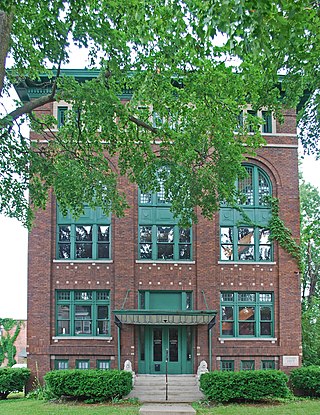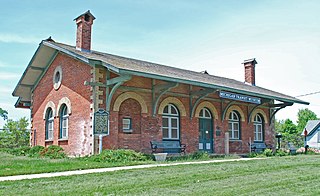
Marycrest College Historic District is located on a bluff overlooking the West End of Davenport, Iowa, United States. The district encompasses the campus of Marycrest College, which was a small, private collegiate institution. The school became Teikyo Marycrest University and finally Marycrest International University after affiliating with a Japanese educational consortium during the 1990s. The school closed in 2002 because of financial shortcomings. The campus has been listed on the Davenport Register of Historic Properties and on the National Register of Historic Places since 2004. At the time of its nomination, the historic district consisted of 13 resources, including six contributing buildings and five non-contributing buildings. Two of the buildings were already individually listed on the National Register.

Jackson station is a historic Amtrak station in Jackson, Michigan, United States. It is served by three daily Wolverine trains between Chicago and Pontiac and a single daily Amtrak Thruway bus between Toledo, Detroit, Jackson, and East Lansing. The station was added to the National Register of Historic Places in 2002.

The Cass–Davenport Historic District is a historic district containing four apartment buildings in Detroit, Michigan, roughly bounded by Cass Avenue, Davenport Street, and Martin Luther King, Jr. Boulevard. The district was listed on the National Register of Historic Places in 1997. The Milner Arms Apartments abuts, but is not within, the district.

The Jefferson Intermediate School is a school building located at 938 Selden Street in Detroit, Michigan. It is also known as Jefferson Junior High School or Jefferson School. The school was listed on the National Register of Historic Places in 1997.

The Cass Park Historic District is a historic district in Midtown Detroit, Michigan, consisting of 25 buildings along the streets of Temple, Ledyard, and 2nd, surrounding Cass Park. It was listed on the National Register of Historic Places in 2005 and designated a city of Detroit historic district in 2016.

The Helen Newberry Nurses Home is a multi-unit residential building located at 100 East Willis Avenue in Midtown Detroit, Michigan. It was listed on the National Register of Historic Places in 2008, and is now the Newberry Hall Apartments.

The Lancaster and Waumbek Apartments were small apartment buildings respectively located at 227-29 and 237-39 East Palmer Avenue in Detroit, Michigan. The apartments were listed on the National Register of Historic Places in 1997. They were demolished in November 2005.

The Palmer Park Boulevard Apartments District is a collection of three apartment buildings located in Highland Park, Michigan. The district was listed on the National Register of Historic Places in 1992.

The Reo Motor Car Company Plant was an automotive manufacturing factory, built for the REO Motor Car Company, located at 2100 South Washington Street Lansing, Michigan. It was designated a National Historic Landmark (NHL) and listed on the National Register of Historic Places (NRHP) in 1978, but completely demolished by the beginning of 1980. It was delisted from the NRHP in 1986.

The Jefferson–Chalmers Historic Business District is a neighborhood located on East Jefferson Avenue between Eastlawn Street and Alter Road in Detroit, Michigan. The district is the only continuously intact commercial district remaining along East Jefferson Avenue, and was listed on the National Register of Historic Places in 2004.

The Hoosick Falls Armory is located along Church Street in Hoosick Falls, New York, United States. It is a red brick building with castellated tower dating to the late 19th century.

The Fort Washington Avenue Armory, also known as the Fort Washington Armory, The Armory, and the 22nd Regiment Armory, is a historic 5,000-seat arena and armory building located at 216 Fort Washington Avenue, between West 168th and 169th Streets, in the Washington Heights neighborhood of Manhattan, New York City. It is a brick Classical Revival building with Romanesque Revival elements, such as the entrance arch, and is currently home to the non-profit Armory Foundation, National Track and Field Hall of Fame, Nike Track and Field Center, and other organizations including the Police Athletic League of New York City.

The Longyear Building is a commercial structure located at 210 North Front Street in Marquette, Michigan. It was listed on the National Register of Historic Places in 2004.

The Masonic Temple Building, located at 314 M.A.C. Avenue in East Lansing, Michigan, is a building constructed in 1916 for the Freemasons. It was listed on the National Register of Historic Places in 1999.

The Masonic Temple Building in Marshall, Michigan is a building from 1913. It was listed on the National Register of Historic Places in 1988. Today it houses Dance Dynamics and Engelter Photography.

The New Scotland Avenue Armory is located on New Scotland Avenue in Albany, New York, United States. It is a large brick building constructed in the early 20th century. In 1994 it was listed on the National Register of Historic Places, one of two armories in the city of Albany to be so designated.

Mount Clemens station is a historic railroad depot located at 198 Grand Street in Mt. Clemens, Michigan. Thomas Edison learned telegraphy at this station in his youth. The building was listed on the National Register of Historic Places in 1981 as the Grand Trunk Western Railroad, Mount Clemens Station and designated a Michigan State Historic Site in 1973. It is now operated as the Michigan Transit Museum.

The Tushiyah United Hebrew School, later known as the Scott Memorial Methodist Episcopal Church, is an educational building located at 609 East Kirby Street in Detroit, Michigan. This building, an important work of architect Isadore M. Lewis, was constructed as the Tushiyah United Hebrew School and served as the headquarters of the United Hebrew Schools of Detroit. It later served as the Scott Memorial Methodist Episcopal Church, the first mainline African-American Methodist Episcopal church in Detroit. It was listed on the National Register of Historic Places in 2011.

The Saginaw Armory is a former National Guard installation located at 234 South Water Street in Saginaw, Michigan. It was listed on the National Register of Historic Places in 2002.

The Michigan Avenue Historic Commercial District in Detroit is a group of commercial buildings located along the south side of two blocks of Michigan Avenue, from 3301–3461. This section of buildings is the most intact collection along this stretch of Detroit's Michigan Avenue. The district was listed on the National Register of Historic Places in 2020.






















